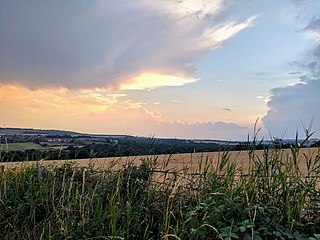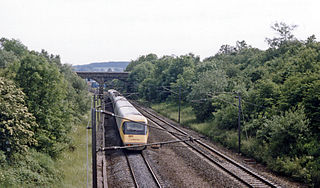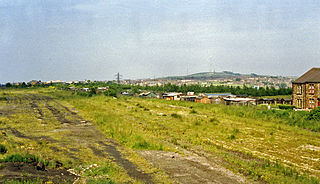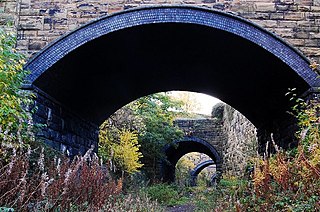The Leek and Manifold Valley Light Railway (L&MVLR) was a narrow gauge railway in Staffordshire, England that operated between 1904 and 1934. The line mainly carried milk from dairies in the region, acting as a feeder to the 4 ft 8+1⁄2 instandard gauge system. It also provided passenger services to the small villages and beauty spots along its route. The line was built to a 2 ft 6 in narrow gauge and to the light rail standards provided by the Light Railways Act 1896 to reduce construction costs.
Esh Winning is a village, and location of a former colliery, in County Durham, England. It is situated in the Deerness Valley 5 miles (8 km) to the west of Durham. The village was founded by the Pease family in the 1850s to service a new mine on the Esh Estate.

Waterhouses is a village in County Durham, in England. It is situated to the west of Durham, near Esh Winning, on the northern Bank of the River Deerness.

Durham is a railway station on the East Coast Main Line, which runs between London King's Cross and Edinburgh Waverley. The station, situated 14 miles 3 chains south of Newcastle, serves the cathedral city of Durham in County Durham, England. It is owned by Network Rail and managed by London North Eastern Railway.

Bowes railway station was situated on the South Durham & Lancashire Union Railway between Barnard Castle and Kirkby Stephen East.

Barras railway station was situated on the South Durham & Lancashire Union Railway between Barnard Castle and Kirkby Stephen East.

Aldin Grange for Bearpark railway station was located on the Lanchester Valley Railway that operated in County Durham, England. The railway station opened in 1883 as Aldin Grange, and was renamed Aldin Grange for Bearpark about a year later. In 1927 its name was changed to Bearpark. The station closed to passengers in 1939, although miners' gala excursions used the line until 1954, and freight then used the line until 1965.
The Durham–Sunderland line was a railway line in the North East of England. The line no longer exists, but many features along its path are still visible.

Ushaw Moor is an old pit village in County Durham, in England, on the north side of the River Deerness. It is situated to the west of Durham, a short distance to the south of Bearpark. Ushaw Moor falls within the Deerness electoral ward in the City of Durham constituency, whose MP since 2019 has been Mary Foy.
The Deerness Valley Railway was an 8-mile long single track branch railway line that ran along the valley of the River Deerness in County Durham, England. Built by the North Eastern Railway, it ran from Deerness Valley Junction, on the Durham to Bishop Auckland line, to the coal mines along the valley via two intermediate stations, Waterhouses, and Ushaw Moor.
Ushaw Moor railway station, was a station on the Deerness Valley Railway, south of the village of Ushaw Moor in County Durham, was opened on 1 September 1884 by the North Eastern Railway.

Clifton & Lowther railway station was a station on the Lancaster and Carlisle Railway (L&CR) south of Penrith near to the village of Clifton. Although it was the original terminus to cross Pennines rail traffic on the Eden Valley Railway, it was rapidly by-passed by a new line and junction. The station, which was on the West Coast Main Line, was treated as a private stop by the Earls of Lonsdale.

Consett was a railway station built by the North Eastern Railway on the route of the Stanhope and Tyne Railway, in County Durham, North East England. It served the industrial town of Consett, which was best known for its steelworks.

Ferryhill was a railway station located in Ferryhill in County Durham, Northeast England. It was located on what became the East Coast Main Line between Darlington and Durham, close to the junctions with several former branches, including the extant freight-only Stillington Line to Norton-on-Tees and Stockton.
Crook railway station served the town of Crook, County Durham, England. It was located on the Bishop Auckland and Weardale Railway line from Bishop Auckland to Blackhill between Wear Valley Junction and Tow Law, 17 miles (27 km) north west of Darlington.

Ipstones railway station was a railway station that served the village of Ipstones, Staffordshire. It was opened by the North Staffordshire Railway (NSR) in 1905 and closed to passenger use in 1935, but remained open to freight traffic until 1964.

Constance Mary Lewcock OBE born Constance Mary Ellis was a British suffragette, arsonist and socialist.

Heckmondwike Spen was a railway station opened by the London & North Western Railway (LNWR) in Heckmondwike, West Yorkshire, England. The station was one of two in the town of Heckmondwike, the other being Heckmondwike Central which was opened by the Lancashire & Yorkshire Railway (L&Y). Both stations have been closed and the lines they served have closed too although the formations that they occupied have both been converted into greenways.

The River Deerness in County Durham, England is a tributary to the River Browney, which is itself a tributary the River Wear. It rises near Tow Law and descends through the Deerness Valley for a distance of 11.6 miles (18.7 km), passing the villages of Waterhouses, Ushaw Moor and Esh Winning. Its confluence with the River Browney is near Langley Moor.













